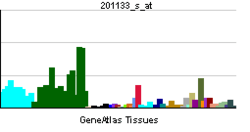PJA2
| View/Edit Human | View/Edit Mouse |
E3 ubiquitin-protein ligase Praja2 is an enzyme that in humans is encoded by the PJA2 gene.[3]
Interactions
PJA2 has been shown to interact with UBE2D2.[4]
References
- ↑ "Human PubMed Reference:".
- ↑ "Mouse PubMed Reference:".
- ↑ "Entrez Gene: PJA2 praja 2, RING-H2 motif containing".
- ↑ Yu, Ping; Chen Yiwang; Tagle Danilo A; Cai Tao (Jun 2002). "PJA1, encoding a RING-H2 finger ubiquitin ligase, is a novel human X chromosome gene abundantly expressed in brain". Genomics. United States. 79 (6): 869–74. doi:10.1006/geno.2002.6770. ISSN 0888-7543. PMID 12036302.
Further reading
- Olsen JV, Blagoev B, Gnad F, et al. (2006). "Global, in vivo, and site-specific phosphorylation dynamics in signaling networks.". Cell. 127 (3): 635–48. doi:10.1016/j.cell.2006.09.026. PMID 17081983.
- Gerhard DS, Wagner L, Feingold EA, et al. (2004). "The status, quality, and expansion of the NIH full-length cDNA project: the Mammalian Gene Collection (MGC).". Genome Res. 14 (10B): 2121–7. doi:10.1101/gr.2596504. PMC 528928
 . PMID 15489334.
. PMID 15489334. - Suzuki Y, Yamashita R, Shirota M, et al. (2004). "Sequence comparison of human and mouse genes reveals a homologous block structure in the promoter regions.". Genome Res. 14 (9): 1711–8. doi:10.1101/gr.2435604. PMC 515316
 . PMID 15342556.
. PMID 15342556. - Strausberg RL, Feingold EA, Grouse LH, et al. (2003). "Generation and initial analysis of more than 15,000 full-length human and mouse cDNA sequences.". Proc. Natl. Acad. Sci. U.S.A. 99 (26): 16899–903. doi:10.1073/pnas.242603899. PMC 139241
 . PMID 12477932.
. PMID 12477932. - Yu P, Chen Y, Tagle DA, Cai T (2002). "PJA1, encoding a RING-H2 finger ubiquitin ligase, is a novel human X chromosome gene abundantly expressed in brain.". Genomics. 79 (6): 869–74. doi:10.1006/geno.2002.6770. PMID 12036302.
- Sasaki A, Masuda Y, Iwai K, et al. (2002). "A RING finger protein Praja1 regulates Dlx5-dependent transcription through its ubiquitin ligase activity for the Dlx/Msx-interacting MAGE/Necdin family protein, Dlxin-1.". J. Biol. Chem. 277 (25): 22541–6. doi:10.1074/jbc.M109728200. PMID 11959851.
- Ishikawa K, Nagase T, Nakajima D, et al. (1998). "Prediction of the coding sequences of unidentified human genes. VIII. 78 new cDNA clones from brain which code for large proteins in vitro.". DNA Res. 4 (5): 307–13. doi:10.1093/dnares/4.5.307. PMID 9455477.
- Mishra L, Tully RE, Monga SP, et al. (1997). "Praja1, a novel gene encoding a RING-H2 motif in mouse development.". Oncogene. 15 (19): 2361–8. doi:10.1038/sj.onc.1201405. PMID 9393880.
- Bonaldo MF, Lennon G, Soares MB (1997). "Normalization and subtraction: two approaches to facilitate gene discovery.". Genome Res. 6 (9): 791–806. doi:10.1101/gr.6.9.791. PMID 8889548.
- Nakayama M, Miyake T, Gahara Y, et al. (1995). "A novel RING-H2 motif protein downregulated by axotomy: its characteristic localization at the postsynaptic density of axosomatic synapse.". J. Neurosci. 15 (7 Pt 2): 5238–48. PMID 7623148.
This article is issued from Wikipedia - version of the 6/4/2016. The text is available under the Creative Commons Attribution/Share Alike but additional terms may apply for the media files.

